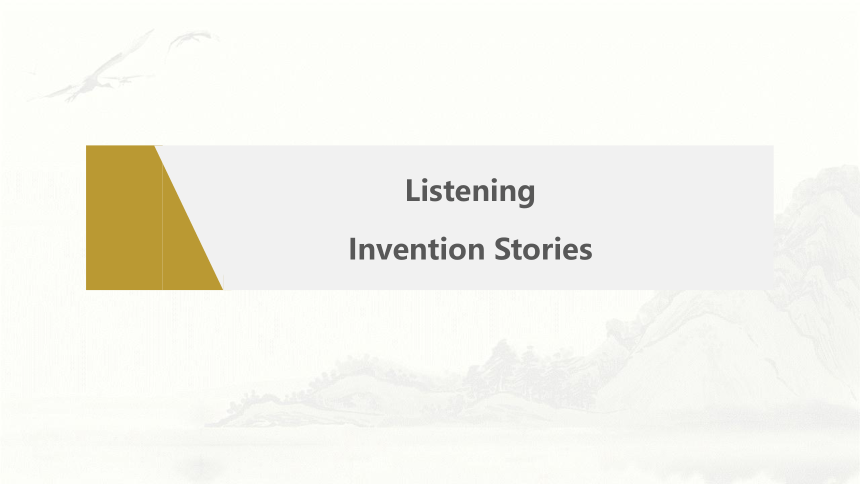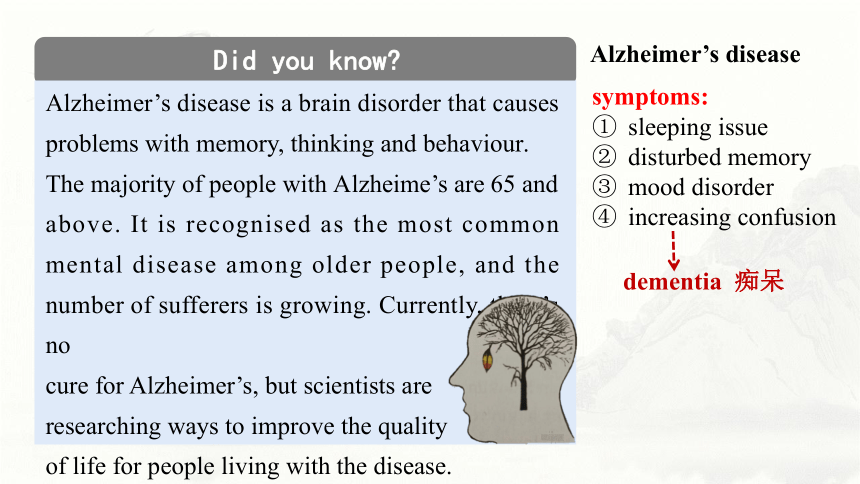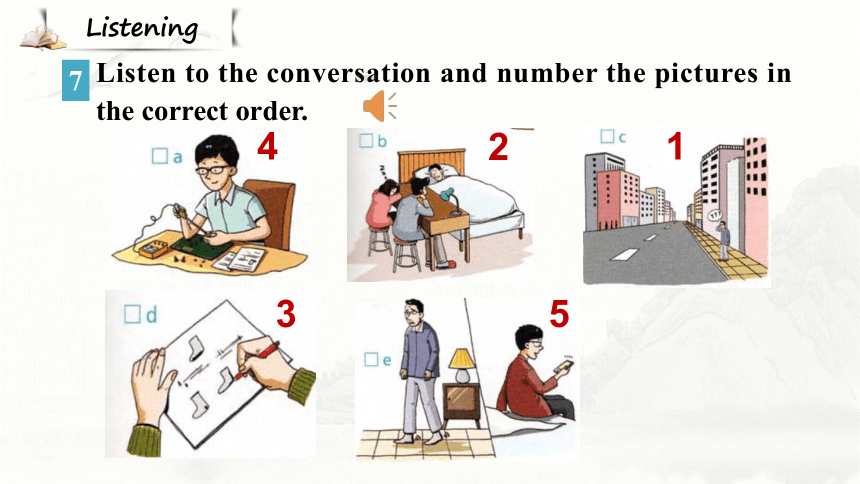外研版(2019)必修 第三册Unit 3 The world of science Listening Invention Stories 课件 (共17张PPT 内嵌视频)
文档属性
| 名称 | 外研版(2019)必修 第三册Unit 3 The world of science Listening Invention Stories 课件 (共17张PPT 内嵌视频) |  | |
| 格式 | pptx | ||
| 文件大小 | 19.0MB | ||
| 资源类型 | 教案 | ||
| 版本资源 | 外研版(2019) | ||
| 科目 | 英语 | ||
| 更新时间 | 2023-10-15 11:11:46 | ||
图片预览







文档简介
(共17张PPT)
Unit 3
The world of science
Listening
Invention Stories
Watch a video to find out what is Alzheimer’s disease.
Lead-in
Lead-in
Did you know
Alzheimer’s disease is a brain disorder that causes problems with memory, thinking and behaviour.
The majority of people with Alzheime’s are 65 and above. It is recognised as the most common mental disease among older people, and the number of sufferers is growing. Currently, there’s no
cure for Alzheimer’s, but scientists are
researching ways to improve the quality
of life for people living with the disease.
Alzheimer’s disease
symptoms:
sleeping issue
disturbed memory
mood disorder
increasing confusion
dementia 痴呆
If one of your close relatives has the Alzheimer’s disease, what can you do to help him or her
Listen to the conversation and number the pictures in the correct order.
1
2
3
4
5
Listening
7
Listen again and complete the notes.
8
Check your answers.
What is it
It’s 1.__________________________________________.
Who was it invented by
It was invented by 2.__________________called Kenneth.
Who inspired the invention
3.______________, who has Alzheimer’s.
How does it work
4._________is sent to a mobile phone like an alarm when the person with it 5.____________.
a student from New York
a pair of socks designed for people with Alzheimer’s diseases
His grandfather
A warning
gets out of bed
Now talk about how the speakers describe the story behind an invention. Listen again if necessary.
He used exclamatory sentences(感叹句) to describe the story. Like:
“How amazing!”
“What a useful invention and caring grandson!”
Learning to learn
Exclamatory sentences express strong emotions, such as surprise, shock, joy, emphasis and excitement. These are usually formed with what or how, and in written form usually end with an exclamation mark.
Mike: Hey, look! I’ve read about a cool invention in this magazine!
Anna: A pair of socks
Mike: Yes, but they’re not ordinary socks. This is a product designed for people with Alzheimer’s disease.
Anna: Oh yes, I saw a TV show about that. It was invented by a student from New York called Kenneth. He even won an award for it at a science fair!
Mike: Wow! How did he come up with the idea
Anna: Well, his grandfather has Alzheimer’s. He forgets things and gets lost easily. Once he got lost in the city and it took a whole day to find him! The family was always worrying about him leaving the house and had to keep an eye on him—even at night! Kenneth had been trying to find a solution. Then one night, he was looking after his grandfather and saw him get out of bed and step on the floor. That moment inspired him, and a good idea came to his mind.
Listening material
Mike: I didn’t know that! How did that moment inspire him
Anna: Well, it made him think of putting a device into a pair of socks to sense pressure. He started by drawing his ideas, and then he thought about how to power the device. Eventually, he created a device the size of a coin!
Mike: Like a coin So how does it work
Anna: He got his grandfather to wear the socks. When his feet touched the floor, the device sensed an increase of pressure, and a warning was sent to the boy’s mobile phone—like an alarm. That way, he could know his grandfather was getting out of bed without staying up all night.
Mike: How amazing! What a useful invention and caring grandson!
Anna: Yes, you are quite right.
You are going to give a presentation about the invention of the telephone. As part of your research, you speak to Student B who has just read a book about it. Ask him/her questions to find out more information.
Student A
You’ve just read a book about the invention of the telephone.
Student A, who is going to give a presentation on the same topic, asks
you for information.
Student B
9
Work in pairs. Act out the conversation about the invention of the telephone.
Information you’d like to know:
the inventor
year of invention
the inventing process
the first phone call
other interesting things about the invention
Student A
Who invented..
When was… invented
How was … invented
What was the first phone call about
What other interesting things…
Useful expressions
Student B
Inventor: Alexander Graham Bell
Invention created in: 1876
Background: Bell was a teacher at a school for the deaf. He tried to invent a machine to send messages over an electronic wire. This eventually led to the idea of a telephone. Later, with his assistant, he created a device to produce and receive sound waves using electrical signals.
First phone call: On 10 March 1876, Bell made the first clear and complete phone call to his assistant, saying, “Mr Watson-come here-I want to see you.”
Other information: Bell never had a telephone in his study, where he wanted to be alone with his thoughts and work.
The telephone was invented by… in…
When…,he…
He later…, and finally…
The first phone call was about…
It is interesting that…
Useful expressions
Show Time
Unit 3
The world of science
Listening
Invention Stories
Watch a video to find out what is Alzheimer’s disease.
Lead-in
Lead-in
Did you know
Alzheimer’s disease is a brain disorder that causes problems with memory, thinking and behaviour.
The majority of people with Alzheime’s are 65 and above. It is recognised as the most common mental disease among older people, and the number of sufferers is growing. Currently, there’s no
cure for Alzheimer’s, but scientists are
researching ways to improve the quality
of life for people living with the disease.
Alzheimer’s disease
symptoms:
sleeping issue
disturbed memory
mood disorder
increasing confusion
dementia 痴呆
If one of your close relatives has the Alzheimer’s disease, what can you do to help him or her
Listen to the conversation and number the pictures in the correct order.
1
2
3
4
5
Listening
7
Listen again and complete the notes.
8
Check your answers.
What is it
It’s 1.__________________________________________.
Who was it invented by
It was invented by 2.__________________called Kenneth.
Who inspired the invention
3.______________, who has Alzheimer’s.
How does it work
4._________is sent to a mobile phone like an alarm when the person with it 5.____________.
a student from New York
a pair of socks designed for people with Alzheimer’s diseases
His grandfather
A warning
gets out of bed
Now talk about how the speakers describe the story behind an invention. Listen again if necessary.
He used exclamatory sentences(感叹句) to describe the story. Like:
“How amazing!”
“What a useful invention and caring grandson!”
Learning to learn
Exclamatory sentences express strong emotions, such as surprise, shock, joy, emphasis and excitement. These are usually formed with what or how, and in written form usually end with an exclamation mark.
Mike: Hey, look! I’ve read about a cool invention in this magazine!
Anna: A pair of socks
Mike: Yes, but they’re not ordinary socks. This is a product designed for people with Alzheimer’s disease.
Anna: Oh yes, I saw a TV show about that. It was invented by a student from New York called Kenneth. He even won an award for it at a science fair!
Mike: Wow! How did he come up with the idea
Anna: Well, his grandfather has Alzheimer’s. He forgets things and gets lost easily. Once he got lost in the city and it took a whole day to find him! The family was always worrying about him leaving the house and had to keep an eye on him—even at night! Kenneth had been trying to find a solution. Then one night, he was looking after his grandfather and saw him get out of bed and step on the floor. That moment inspired him, and a good idea came to his mind.
Listening material
Mike: I didn’t know that! How did that moment inspire him
Anna: Well, it made him think of putting a device into a pair of socks to sense pressure. He started by drawing his ideas, and then he thought about how to power the device. Eventually, he created a device the size of a coin!
Mike: Like a coin So how does it work
Anna: He got his grandfather to wear the socks. When his feet touched the floor, the device sensed an increase of pressure, and a warning was sent to the boy’s mobile phone—like an alarm. That way, he could know his grandfather was getting out of bed without staying up all night.
Mike: How amazing! What a useful invention and caring grandson!
Anna: Yes, you are quite right.
You are going to give a presentation about the invention of the telephone. As part of your research, you speak to Student B who has just read a book about it. Ask him/her questions to find out more information.
Student A
You’ve just read a book about the invention of the telephone.
Student A, who is going to give a presentation on the same topic, asks
you for information.
Student B
9
Work in pairs. Act out the conversation about the invention of the telephone.
Information you’d like to know:
the inventor
year of invention
the inventing process
the first phone call
other interesting things about the invention
Student A
Who invented..
When was… invented
How was … invented
What was the first phone call about
What other interesting things…
Useful expressions
Student B
Inventor: Alexander Graham Bell
Invention created in: 1876
Background: Bell was a teacher at a school for the deaf. He tried to invent a machine to send messages over an electronic wire. This eventually led to the idea of a telephone. Later, with his assistant, he created a device to produce and receive sound waves using electrical signals.
First phone call: On 10 March 1876, Bell made the first clear and complete phone call to his assistant, saying, “Mr Watson-come here-I want to see you.”
Other information: Bell never had a telephone in his study, where he wanted to be alone with his thoughts and work.
The telephone was invented by… in…
When…,he…
He later…, and finally…
The first phone call was about…
It is interesting that…
Useful expressions
Show Time
